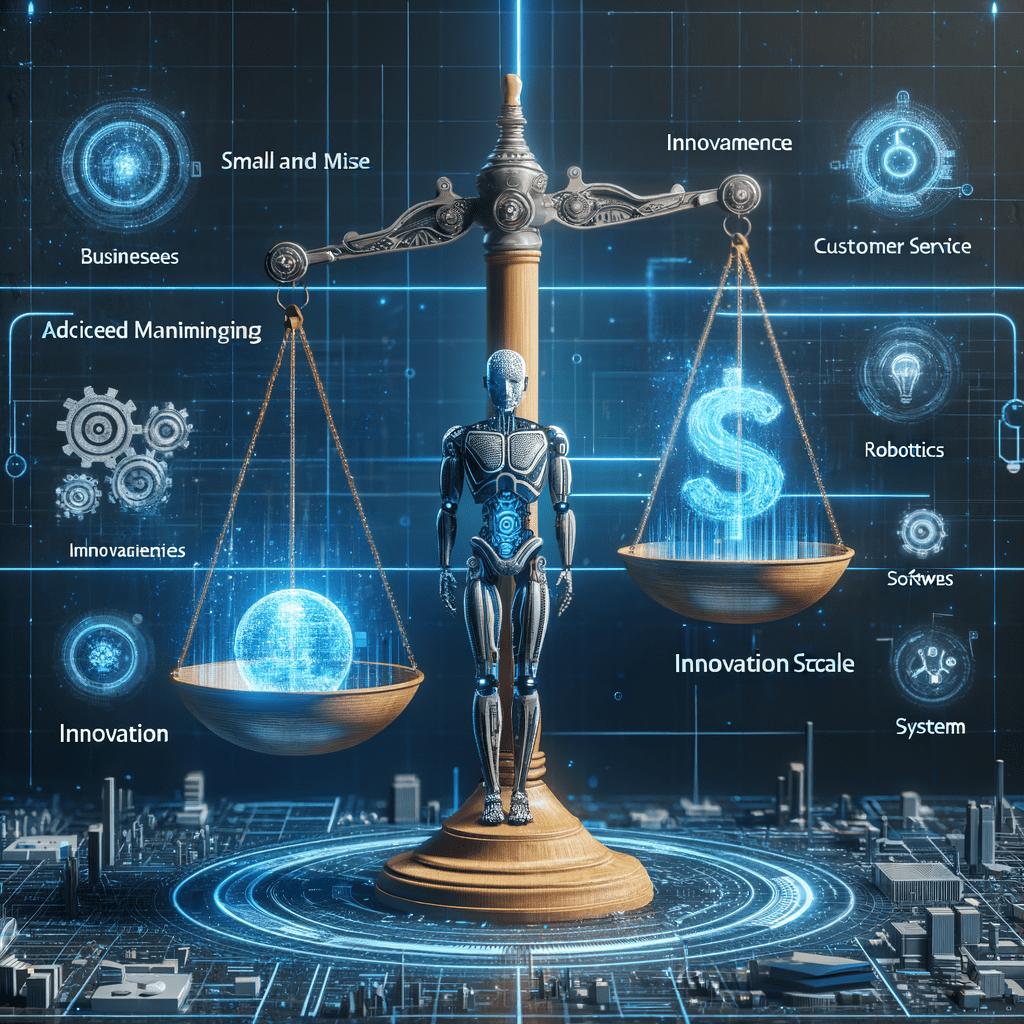The buzz around AI is deafening, but it’s not just for big tech giants. The future of AI in small and mid-size companies is here, and it’s transforming how businesses operate.
Small businesses increasingly recognize the need for AI integration to maintain a competitive edge. Let’s explore this exciting technology and its potential to reshape daily business operations.
AI’s Impact on Small and Mid-size Businesses
AI adoption is rapidly rising. McKinsey found that regular AI use nearly doubled in just ten months.
This surge is impacting smaller companies, offering powerful advantages. AI empowers employees, handling repetitive tasks so they can focus on strategy, creativity, and customer connections.
Boosting Efficiency and Productivity
Consider the tedious tasks consuming your team’s time: data entry, scheduling, basic customer support. AI can automate these processes, freeing up employees for more strategic work.
IBM studies reveal that AI chatbots can handle up to 80% of routine customer questions, significantly reducing operating costs. Other research shows AI can help employees save up to 66% of their time on administrative tasks.
This time can be redirected to tasks like relationship building, campaign development, and other human-centric activities that AI can’t perform. AI-powered virtual assistants and other AI applications further contribute to boosting productivity and operational efficiency. This streamlines operations and enhances the employee experience, allowing them to dedicate more time to mission-critical endeavors and creative problem-solving.
Supercharging Sales and Marketing
AI enhances personalization in marketing campaigns. Instead of generic emails, AI tailors messages based on individual customer interests and past behaviors.
This personal touch can improve customer engagement and increase revenue by up to 20%, also impacting marketing ROI. AI can boost return on investment by up to 30%.
Imagine smarter email campaigns, perfectly timed with compelling subject lines and personalized content. Lead generation statistics reveal that AI-powered chatbots can autonomously generate up to 30% of leads. This allows sales teams to concentrate on closing deals instead of managing initial interactions. This enhances customer relationships and builds stronger connections.
Optimizing Operations and Customer Service
Small and medium-sized businesses can also leverage AI to optimize their operations. McKinsey highlights the potential for a 30% reduction in operational costs through intelligent automation and resource allocation. This includes improved forecasting, inventory management, and streamlining logistics using machine learning and predictive analytics.
AI provides 24/7 customer support. AI systems can provide instant answers and quick solutions, improving response times and customer satisfaction. A happy customer is a returning customer, which contributes to the overall customer lifetime value.
Transforming Industries with AI
Beyond individual business functions, AI is reshaping entire industries through AI solutions. Let’s delve into a few examples across different sectors. Small and midsize businesses are at the forefront of this change.
E-commerce and Retail
AI analyzes purchasing patterns, identifies up-selling and cross-selling opportunities, and helps businesses understand market trends and investment potential. This includes small and medium-sized e-commerce businesses exploring the future of AI in e-commerce.
AI-powered dynamic pricing models can optimize margins by monitoring real-time demand. These models boost revenue by 10-20%, helping businesses stay competitive and offer personalized product recommendations.
This allows businesses to anticipate customer needs and prevent them from turning to competitors, leveling the playing field with e-commerce giants.
Finance and Accounting
AI can automate financial management. AI accounting tools could save small firms an estimated 341,000 hours of financial operations work annually.
Automated bookkeeping and smart platforms eliminate manual data entry. Invoicing, expenses, and reports are processed much faster. These platforms handle accounts payable (A/P) and accounts receivable (A/R), saving significant costs. This frees up financial professionals for higher-value tasks, like financial analysis and planning.
These savings can be invested in growth initiatives instead of administrative duties. AI tools can also provide valuable financial insights and help make informed decisions.
Healthcare and Legal
While access to AI in specialized fields may still be developing, the future holds great potential. In legal practices, AI can expedite legal research and automate document review, saving time and improving client service.
In healthcare, AI offers quick symptom analysis. AI technologies like natural language processing can assist healthcare professionals in analyzing patient data and making faster, more informed diagnoses. This is one example of AI’s potential to enhance service accessibility and cost-effectiveness.
While adoption in these sectors may require greater investment, it promises more efficient and affordable services. AI tools will enable businesses to offer enhanced services to clients and patients, and improve efficiency. This advancement will greatly benefit smaller providers as AI technologies become more readily available.
Navigating the Future of AI in Small and Mid-Size Companies
Navigating the rapid evolution of AI in small and mid-size companies requires addressing crucial aspects like tool accessibility, cybersecurity, and available resources. These advancements can revolutionize business landscapes and how small business owners leverage customer data.
Accessible AI Tools
AI-powered platforms and software like QuickBooks and DALL-E 2 are designed to assist companies with various operational aspects. The range of available solutions is continually expanding.
With increased competition and innovation, AI technology is becoming increasingly accessible. This trend makes tools and software less expensive and easier to implement. Businesses can start small with targeted AI initiatives that address specific business needs.
Finding the right fit is simple; just request quotes from various software and tool providers to see what platforms offer to manage AI initiatives for you. This lets businesses of all sizes benefit from AI, harnessing AI’s power to streamline operations, improve customer experience, and drive business growth.
Cybersecurity and Data Privacy
As AI adoption increases, cybersecurity becomes more critical. Cyberattacks targeting small and medium-sized businesses are on the rise, making even basic operations vulnerable to data breaches.
Integrating AI within cybersecurity frameworks offers robust protection for sensitive data. Protecting against cyber threats is an important part of leveraging AI tools, but it does involve investing in security infrastructure.
Protecting customer and business data requires robust AI systems and strategies that keep organizations safe in this new, complex digital environment. Implementing proper cybersecurity practices helps businesses of all sizes build trust with customers.
Training and Resources
The rapid growth of AI is creating new job opportunities. These opportunities, however, require specialized training. Educational platforms like Coursera offer affordable, accessible skill-based courses. This allows employees to gain in-demand skills for various industries, from plumbing to sales to engineering.
Investing in training is crucial for navigating the changing business landscape. This equips employees with the necessary skills to utilize AI effectively and to take on new AI-related roles within the organization. Access to resources, including training programs, plays a crucial role in ensuring employees can fully harness the power of AI.
Staying up-to-date on the latest AI trends and technologies is essential for staying ahead in the competitive market. Investing in the future of your workforce through continuous learning is a key element in embracing the opportunities that AI offers. These resources enable companies to effectively use their customer data and tailor solutions.
FAQs about Future of AI in small and mid-size companies
How will AI affect small businesses?
AI can transform small businesses by boosting productivity, cutting costs, and creating new revenue opportunities.
What is the future of AI for businesses?
The future of AI extends beyond current applications. AI is impacting businesses across all industries, from traditional sectors to those in online e-commerce. AI’s increasing accessibility and affordability will continue to unlock new opportunities for businesses of all sizes. This creates potential for higher returns and sustained growth. The ability of AI to analyze vast amounts of historical data will allow for more efficient and targeted marketing campaigns.
The ability of small businesses to cut costs through using AI while streamlining operations helps free up employees from performing repetitive administrative tasks that are best handled by AI technology like ai-powered chatbots, virtual assistants, natural language processing, image generation, and tools that tackle other complex tasks.
The future of AI in small and mid-size companies is not just a trend but a fundamental shift. It’s a powerful tool that can boost efficiency, fuel growth, and enhance customer experiences. Embracing AI is no longer a luxury but a necessity for businesses looking to thrive in the evolving digital landscape.






